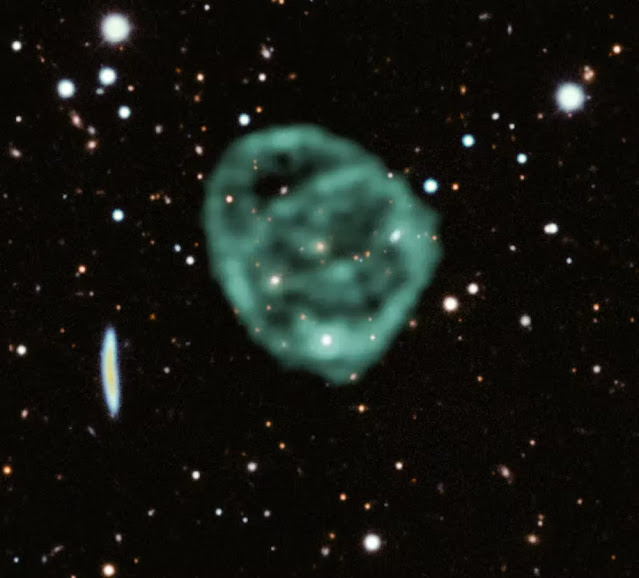A new observation of an Odd Radio Circle, known as the Cloverleaf, is shedding light on its origin.
 |
The multiwavelength image of the Cloverleaf ORC (odd radio
circle). |
Astronomers have stumbled upon a mysterious cosmic
phenomenon called Odd Radio Circles, or ORCs.
These strange circular radio features, discovered around
certain galaxies, have puzzled scientists ever since their first discovery in
2021.
It was previously unknown how these huge circles formed.
Now, a new observation of one particularly intriguing ORC,
known as the Cloverleaf, is shedding light on its origin. Researchers postulate
that it formed through the dramatic clash of massive groups of galaxies.
An X-ray satellite allowed the scientists to see this
mysterious structure in a new way. The team suggests that the merging triggered
supersonic shock waves, which rapidly accelerated particles within the
Cloverleaf. These accelerated particles, thus, created the X-ray emissions
observed in this ORC.
“This is the first time anyone has seen X-ray emission
associated with an ORC. It was the missing key to unlock the secret of the
Cloverleaf’s formation,” said Esra Bulbul, an astrophysicist at the Max Planck
Institute for Extraterrestrial Physics in Garching, Germany, who led the study.
Extremely hot surrounding gas
Scientists used X-ray emissions to trace the distribution of
gas within the Cloverleaf structure, revealing that it was generated by the
merging of two independent groups of galaxies.
When galaxies merge, their total mass increases, causing the
surrounding gas to heat and generate X-rays. The X-ray spectrum emission
indicates that the gas is around 15 million degrees Fahrenheit (roughly between
8 and 9 million degrees Celsius.)
“That measurement let us deduce that the Cloverleaf ORC is
hosted by around a dozen galaxies that have gravitated together, which agrees
with what we see in deep visible light images,” said Xiaoyuan Zhang, a
postdoctoral researcher.
 |
The image of the first ORC (odd radio circle) ever
discovered, aptly dubbed ORC-1. Source: NASA |
ORCs are hard to find
Interestingly, the scientists suggest that the acceleration
of particles from this ORC is likely associated with a black hole.
“One fascinating idea for the powerful radio signal is that
the resident supermassive black holes went through episodes of extreme activity
in the past, and relic electrons from that ancient activity were reaccelerated
by this merging event,” said Kim Weaver, the NASA project scientist for
XMM-Newton.
ORCs are extremely difficult to detect because of their
faint signals. So far, just eight of these formations have been identified in
random locations beyond our galaxy. And they are massive enough to “envelop an
entire galaxy — sometimes several.”
“The power needed to produce such an expansive radio
emission is very strong. Some simulations can reproduce their shapes but not
their intensity. No simulations explain how to create ORCs,” said Bulbul in the
press release.
Cloverleaf’s powerful emission was first spotted using data
from eROSITA (Extended Roentgen Survey with an Imaging Telescope Array), an
orbiting German/Russian X-ray observatory. The follow-up observations were made
using ESA’s XMM-Newton.
ORCs are rare, and their strong emissions remain a mystery. The team further plans to acquire deeper insights from both of these telescopes.